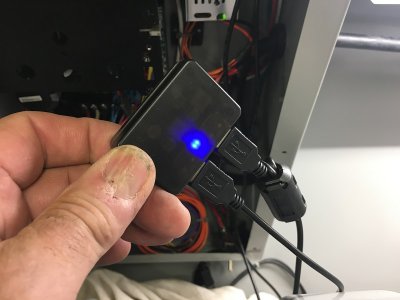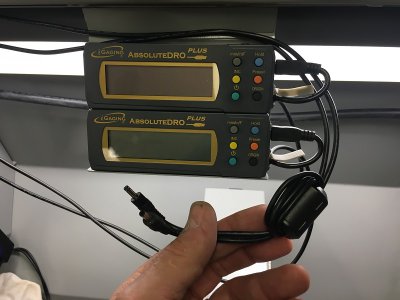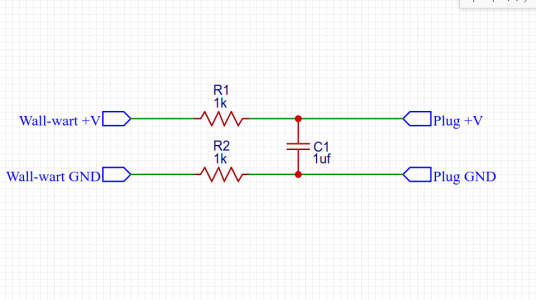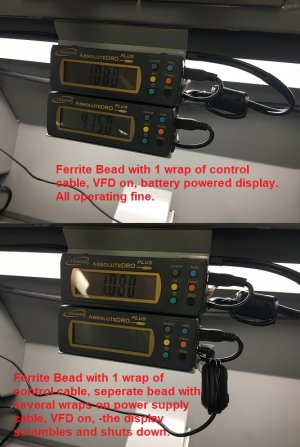I'm going to make one more run at fixing the RFI/EMI problem because I suspect I may have other issues in the shop induced by the VFD later down the line and I may be able learn something here and maybe it will help someone else. I have a CNC router with long run times and soon to be 3D printer with same. I've already had the CNC router exhibit self induced RFI problems that needed to be fixed. Wouldn't be the end of the world if I could run the lathe while those were running but certainly suboptimal.
There is definitely a conducted EMI problem with the VFD too because with it switched on, I can't power the iGaging DROs from the wall wart in any shop receptacle away from the lathe, but switch off the VFD and it powers up and displays well from anywhere, so the VFD is conducting back EMI/RFI through all my shop circuits.
I bought some cheap parts but they may take a few days to receive them with the holiday season. I do have couple questions I'll pose later below.
If no success, I'm happy to just run the DROs off of battery but it won't be that fancy battery pack in the post above. Turns out, that battery is meant to re-charge a phone battery not be a power source, and when it senses low draw for 30 seconds or so, it shuts off as sensing it has charged the phone battery. The DROs don't draw enough to keep it active. So some of what I thought were the DROs being taken down by RFI while the battery was plugged in was really just the battery pack shutting off, and when that happens, the DRO bypasses the internal coin cell battery because it senses the barrel plug in the socket, but doesn't have power......good grief.
One other tidbit I hadn't previously mentioned, when I rec'd the VFD, as I was reading the manual, it said it cannot be operated on a GFI circuit. Well, code required all the 120vac circuits in a garage to be GFI. There is a custom version of the VFD for GFI circuits that has both hardware and software differences and cost twice as much so probably wouldn't have bought it even if I had known. I just removed the GFI receptacle and installed a non-GFI receptacle. I know what the GFI does but not sure how/if the mechanism could affect this conducted EMI problem. I think the reason the VFD won't work on GFI circuit has to do how it senses current for overload protection and maybe even switching functions. This may also prevent me from installing any inline suppression devices which may mean the lathe simply doesn't run while other sensitive equipment in the shop runs. I'll put that question to the VFD manufacture.
So the RFI fix questions are:
Best,
Kelly
There is definitely a conducted EMI problem with the VFD too because with it switched on, I can't power the iGaging DROs from the wall wart in any shop receptacle away from the lathe, but switch off the VFD and it powers up and displays well from anywhere, so the VFD is conducting back EMI/RFI through all my shop circuits.
I bought some cheap parts but they may take a few days to receive them with the holiday season. I do have couple questions I'll pose later below.
If no success, I'm happy to just run the DROs off of battery but it won't be that fancy battery pack in the post above. Turns out, that battery is meant to re-charge a phone battery not be a power source, and when it senses low draw for 30 seconds or so, it shuts off as sensing it has charged the phone battery. The DROs don't draw enough to keep it active. So some of what I thought were the DROs being taken down by RFI while the battery was plugged in was really just the battery pack shutting off, and when that happens, the DRO bypasses the internal coin cell battery because it senses the barrel plug in the socket, but doesn't have power......good grief.
One other tidbit I hadn't previously mentioned, when I rec'd the VFD, as I was reading the manual, it said it cannot be operated on a GFI circuit. Well, code required all the 120vac circuits in a garage to be GFI. There is a custom version of the VFD for GFI circuits that has both hardware and software differences and cost twice as much so probably wouldn't have bought it even if I had known. I just removed the GFI receptacle and installed a non-GFI receptacle. I know what the GFI does but not sure how/if the mechanism could affect this conducted EMI problem. I think the reason the VFD won't work on GFI circuit has to do how it senses current for overload protection and maybe even switching functions. This may also prevent me from installing any inline suppression devices which may mean the lathe simply doesn't run while other sensitive equipment in the shop runs. I'll put that question to the VFD manufacture.
So the RFI fix questions are:
- I have braided shielding I can pull over the cables. Probably won't do anything but I have plenty of it. Is suspect it is better to shield the power cables since they are the source rather than the control cables. Is that so? Could do both and I will reroute the control and power cables apart from one another to extent possible.
- I bought an assortment of ferrite beads, two dozen for $9 delivered in different sizes. I have a few spots on my CNC router that could use them too. They are cheapies and I don't know what the core material is or intended frequency range, but even if I did, I wouldn't know which one to select. I'll try them in single pass and looped. Should they be placed on both ends of the power cables? I may also place a couple more on the supply power to/from the VFD. I presume the cable should not be have braided shielding in the area of the beads. Is that so?
- For the conducted part of the problem, I bought a 12vdc to 5vdc Buck Convertor, thinking my 12vdc from the regulated supply seems to be a clean source. It's only a $10 part but I need one for my ATV so if it doesn't work on the DRO, I'll use it there. I don't know much about those. Is it like to be another source of noise?
Best,
Kelly






